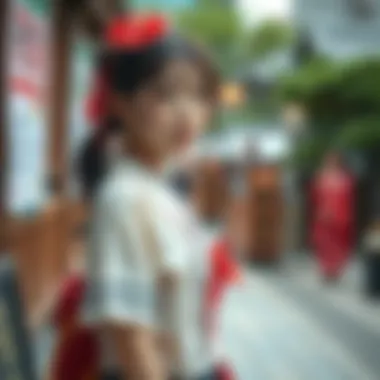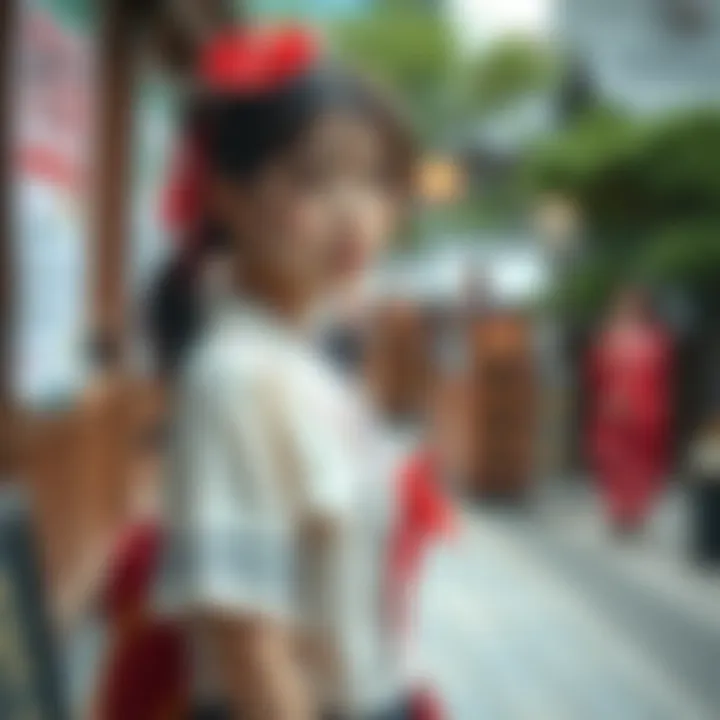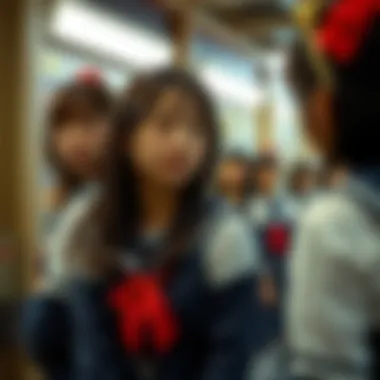The Japanese Schoolgirl Uniform: History and Influence


Intro
The Japanese schoolgirl uniform, often immediately recognizable by its distinct style and design, tells a story that begins in the 19th century. This iconic clothing item weaves together threads of history, fashion, and culture, offering insight into societal norms and the evolution of youth identity in Japan. From its roots in educational reforms to its status as a cultural symbol both locally and globally, the uniform is not merely an outfit—it's a tapestry of history and significance.
Across the years, the uniform has transformed, adopting various styles influenced by changing fashion trends, societal perceptions, and even subcultures. The simple elements of a blouse, pleated skirt, and blazer became expressions of individual identity, rebellion, and conformity all at once. With contemporary iterations making their way into fashion runways and pop culture, it's clear that the Japanese schoolgirl uniform has far-reaching implications, blending tradition with modernity in unexpected ways.
In this article, we will delve deeper into the multifaceted nature of the schoolgirl uniform. We will take a closer look at its historical development, dissect the various design elements that constitute its style, and explore its cultural significance—from how it represents youth to its influence around the world. Along the way, we’ll also touch upon the current trends in fashion as well as the growing emphasis on sustainability within the industry. So, let’s embark on this journey to discover what lies under the surface of this celebrated garment.
Historical Development of the Japanese Schoolgirl Uniform
The historical trajectory of the Japanese schoolgirl uniform is not just a tale of fabric and patterns, but rather an exploration of the shifting tides in education, culture, and society. It represents a blend of practicality, identity, and aesthetics that has evolved over decades. Understanding this evolution helps illuminate the broader themes of how external influences shape internal identities, particularly within educational environments. This section will walk through the influences and changes that have sculpted the uniform, providing a nuanced perspective on its significance.
Early Influences in Education
The story begins well before World War II, around the late 19th century, when Japan was undergoing a massive transformation. The Meiji Restoration in 1868 erased the Tokugawa shogunate’s isolationism, opening Japan to Western influences. Educational reforms followed suit, aiming to modernize the nation's system. Initial uniforms for girls were a reflection of Western designs, showcasing elements borrowed from European attire like blouses and skirts. Education, at that time, was leaving the realm of solely male instruction, as girls began to enter schools in higher numbers. These early uniforms aimed for practicality but also highlighted the beginning of a perennial quest for identity within educational settings.
The Emergence of Uniforms in Japanese Schools
Come the 1900s, uniforms began to solidify their presence in Japanese schools. The government mandated uniforms as part of the general education reform. Not merely a dress code, school uniforms became a representation of discipline and unity among students.* The introduction of the sailor-style uniform in the 1920s marked a pivotal moment—a silhouette that remains iconic even today. This design was influenced by both military and naval attire, aiming to instill a sense of order while also promoting camaraderie among schoolgirls. It carved out a space where individual schools could impose a unique flavor through variations in color, fabrics, and accessories.
Post-war Modifications and Influence
The end of World War II was a transformative period, ushering in a wave of changes across various aspects of Japanese life, including education. Amidst a push for democratization, uniforms became less rigidly about discipline and more a matter of personal expression and cultural identity. In the 1950s and 1960s, post-war designs began incorporating vibrant fabrics and playful accessories, transitioning from merely being functional garments to embedding meaning in their styles. Notably, the uniforms evolved to include shorter skirts, which sparked debates on issues of femininity and sexuality. The media, particularly anime and manga, started portraying these uniforms in diverse lights, further enhancing their cultural footprint and making them a staple of youth culture.
This historical development of the Japanese schoolgirl uniform showcases a fascinating journey through societal attitudes and educational reforms. More than a mere artifact of clothing, it serves as a lens through which to view the transitions in values, attitudes, and identities within Japanese society. Understanding this evolution lays the groundwork for delving deeper into the design and cultural implications of these uniforms.
Structure and Design of the Uniform
The design of the Japanese schoolgirl uniform is not merely a matter of fabric and stitches; it encapsulates a rich narrative woven through time and tradition. Understanding its structure and design is key to appreciating the broader cultural implications it carries. There’s more than meets the eye with these uniforms. They serve to unify a school’s demographic, foster discipline, and, as often noted, reflect broader societal trends. This structured garment reflects a code and a character. It’s a canvas, displaying ideals of youth, education, and cultural values.
Key Components and Fabrics Used
The Japanese schoolgirl uniform consists mainly of a few staple components, each contributing to its unique identity. The iconic skirt, most commonly a pleated design, is often paired with a crisp blouse or shirt, and on colder days, a blazer or a cardigan might be added. This layered approach not only provides practicality but also allows for personal expression within the established norms.
In terms of materials, cotton blends dominate due to their comfort and durability. Commonly used fabrics include polyester and wool, with each fabric offering distinct characteristics. Polyester, with its moisture-wicking properties, proves ideal for Japan's humid summers, while wool provides warmth during winter months. Schools often opt to use synthetic blends to maintain the uniformity of color and texture, ensuring that each student looks sharp and polished throughout the school day.
Variations Across Schools and Regions


Diversity is another layer of the Japanese schoolgirl uniform. Across Japan’s many schools, variations abound, shaped by regional identities and institutional traditions. For example, in the Kanto region, you might find uniforms featuring a more fitted silhouette, while the Kansai region tends to embrace a looser, more comfortable fit. Some schools even allow students to personalize aspects of their uniforms, like wearing a non-standard hairstyle or adding accessories, which can vary widely from school to school.
Local culture also influences the design. In coastal areas, lighter fabrics and shorter skirts are more common due to the warmer climate. In contrast, students in northern regions may wear heavier wool blends, complete with long sleeves and thicker materials suitable for the cold weather. Thus, the uniform is as much a reflection of geographical factors as it is an educational garment.
Symbolism in Colors and Patterns
The colors and patterns found in school uniforms play a significant role in communicating identity and values. Traditional colors like navy blue, white, and gray dominate the landscape, each symbolizing different facets of academic life. Blue often represents calmness and a desire for trustworthy education, while white is historically associated with purity and fresh starts.
In addition to primary colors, schools may integrate distinctive patterns like stripes or checks, each carrying unique meanings in its local context. These patterns can signify a school's history, motto, or community spirit.
"More than just clothing, these colors and patterns are vital to creating a sense of belonging among students."
Thus, the structure and design of the Japanese schoolgirl uniform not only serve practical purposes but also carry deep symbolic meanings that are vital for identity and culture. In exploring these facets, we can grasp the essence of how such attire contributes to building a collective consciousness in Japanese society.
Cultural Implications of the Uniform
The Japanese schoolgirl uniform transcends mere fabric and stitching; it embodies a myriad of cultural implications that resonate beyond the school gates. This uniform serves as a lens to understand youth culture, identity, and social dynamics within Japan. From its historical roots as a symbol of education to its role in contemporary society, the uniform is intertwined with themes of conformity and rebellion, identity and representation. This section delves into the significant cultural elements tied to the schoolgirl uniform, exploring how it shapes perceptions and influences the lives of those who wear it.
Representation of Youth and Identity
The schoolgirl uniform is often regarded as a representation of youth. It's almost like a rite of passage; as students don these outfits, they step into a world that both restricts and defines them. In Japan, youth and innocence are celebrated, yet simultaneously scrutinized, making the uniform a complex symbol. High school students seem to occupy a special space, navigating between childhood and adulthood.
This significance is twofold:
- Cohesiveness: The uniform fosters a sense of belonging among students. When everyone wears the same outfit, a shared identity emerges, helping to ease the transition into the social dynamics of peer groups.
- Individuality: Paradoxically, individuality becomes a form of expression, as girls often find creative ways to personalize their uniforms through accessories, hairstyles, and even the manner in which they wear their garments. For instance, rolling up the sleeves or tying a loose tie can show one’s uniqueness while still adhering to a communal identity.
Influence in Popular Culture
The Japanese schoolgirl uniform has seeped into various strands of popular culture, gaining notable prominence in anime, fashion, and global media. It evokes certain feelings and images, often romanticized and fetishized in pop culture, where characters sporting these uniforms represent a specific archetype—the innocent yet adventurous young woman.
This influence can be seen in:
- Anime and Manga: A myriad of shows depict female characters in school uniforms, where their attire often signifies their role in the narrative, influencing global perceptions of Japanese society.
- Fashion Trends: Beyond the screen, Western fashion has drawn inspiration from these uniforms, resulting in adaptations that merge aesthetic appeal with cultural homage. Designers like Rei Kawakubo and brands such as Comme des Garçons have accentuated elements from the Japanese uniform in their collections, demonstrating its lasting impact on the global fashion landscape.
Controversies and Criticisms
However, the allure of the schoolgirl uniform does not come without its share of controversies. Critics point to issues of hypersexualization and the reinforcement of certain stereotypes. Some argue that the cultural presentation of uniforms in media can lead to a narrow understanding of youth.


- Hypersexualization: Some media portrayals focus heavily on the sexual appeal of the uniform, particularly in anime and advertising. This fixation can distort perceptions and may contribute to unhealthy attitudes towards young women.
- Pressure on Identity: There's a consistent societal pressure for young girls to embody specific traits associated with the uniform. The weight of expectation can lead to a loss of individuality, as students navigate the thin line between conformity and self-expression.
Modern Interpretations and Adaptations
In today’s fast-paced fashion world, the traditional Japanese schoolgirl uniform has morphed into something that reflects contemporary trends and global influences. Far from being confined to school campuses, these uniforms have taken a front-row seat on the runway and street fashion alike. This transition illustrates how historic garments can shed their conventional roles and adapt to modern sensibilities, revealing a dynamic cultural dialogue.
Fashion Trends Influenced by the Uniform
The Japanese schoolgirl uniform, characterized by its sharp lines and tailored fit, has inspired an array of fashion trends. Influencers and designers frequently borrow elements such as the pleated skirt, crisp white shirt, and blazer styles, integrating them into mainstream attire. For instance, designers like Yohji Yamamoto and Junya Watanabe have dissected the uniform’s aesthetics, presenting avant-garde pieces that still echo the familiar silhouette.
- Streetwear: The schoolgirl uniform’s influence extends into streetwear, where it combines with urban styles. Pieces such as oversized sweatshirts paired with shorter skirts have captured the imagination of young fashion enthusiasts worldwide.
- Layering: Modern interpretations embrace layering, combining the schoolgirl's elements with contemporary pieces, such as denim jackets or graphic tees, to create a look that is both nostalgic and current.
- Seasonal Adaptations: Designs are also evolving with seasons. Lightweight fabrics become popular in the summer, while thicker, warmer materials are favored in winter collections, demonstrating the versatility of these garments across different climates.
Street Fashion and Subculture Identity
Street fashion is a remarkable expression of identity and culture. The Japanese schoolgirl uniform has found a significant place within various subcultures not only in Japan but globally. For instance, the Gyaru and Lolita cultures thrive on reinterpretations of the uniform, transforming traditional elements into vibrant statements of individuality.
- Gyaru Style: This subculture emphasizes an energetic, sun-kissed aesthetic. Gyaru fashion often incorporates bright colors, bold accessories, and playful patterns while paying homage to the uniform’s original structure.
- Lolita Fashion: Alternatively, the Lolita movement takes a more elegant and historical approach. Many Lolitas adopt the uniform’s structure but infuse it with Victorian-inspired elements, creating an entirely different narrative.
- Global Adaptations: As these styles spread beyond Japan's borders, they become a means for young individuals to assert their identities against cultural backdrops. In the West, for instance, similar designs are often adopted in various forms, showcasing an eclectic mix of influences.
International Adaptations and Styles
The global fascination for the Japanese schoolgirl uniform has prompted adaptations around the world. Countries with different cultures have embraced the iconic silhouette, blending it with local fashion sensibilities. This cultural exchange has led to the emergence of unique styles that still resonate with the essence of the original uniform.
- Kawaii Culture: The rise of Kawaii (cute) culture has primarily popularized faux schoolgirl outfits among Western youth, who seek to embody what they see as a playful and innocent aesthetic.
- K-Pop Influence: Korean pop culture has also adopted these styles. K-Pop idols frequently sport modern school-inspired outfits, which are both chic and nostalgic, impacting global trends.
- Social Media Trends: Platforms like Instagram and Pinterest showcase diverse adaptations of the schoolgirl uniform, with influencers continuously redefining its boundaries. This accessibility enables a wide audience to reimagine and personalize their interpretations, allowing for endless creativity.
The evolution of the Japanese schoolgirl uniform is a testament to fashion's cyclical nature. It shows how traditions can be both honored and reinterpreted, highlighting the garment's ability to reflect contemporary attitudes and cultures across the globe.
Learn more about fashion trends and global influences.
Sustainability Considerations
Sustainability has taken center stage across various industries, including fashion. When it comes to the Japanese schoolgirl uniform, which has transitioned from historical significance to a global symbol of style, the conversation around sustainability becomes particularly pertinent. Clothing choices today not only reflect personal aesthetics but also speak to broader principles related to environmental health and social awareness. Understanding how the schoolgirl uniform fits into this conversation is crucial for designers, consumers, and fashion enthusiasts alike.
Environmental Impact of Fabric Choices
The fabrics used in schoolgirl uniforms carry significant weight in the discussion of sustainability. Often crafted from synthetic materials like polyester, these fabrics can contribute to considerable environmental impact. Polyester production is energy-intensive and involves petrochemicals that can harm ecosystems. Natural fabrics such as cotton or linen, alternatively, hold the promise of being more sustainable, yet they are not without their own challenges, including intense water usage and pesticide reliance.
Moreover, the lifecycle of a uniform plays a role in its environmental footprint. From production and transportation to disposal, every stage impacts the planet in varying degrees. Embracing sustainable fabrics, organic materials, and eco-friendly dyes can help reduce these harms. With the rising awareness of eco-conscious practices, we see more schools and designers actively seeking to incorporate these principles into the uniform's design.


Trends in Ethical Production
As sustainability starts to sink in as a necessity rather than an afterthought, the urgency for ethical production processes follows closely. This includes ensuring workers are treated fairly and compensated justly throughout the chain of production. Many brands today strive to adhere to additional certifications such as Fair Trade, which oversees labor standards across their factories. When schools choose to source their uniforms from such suppliers, they not only support ethical practices but also show a commitment to social responsibility.
Ethical production isn't just a trend; it's a foundational shift towards creating a more balanced relationship between fashion, society, and the planet.
Consumer Awareness and Choices
Consumer awareness is paramount in the efforts to push sustainable fashion forward. The more consumers understand about where their clothes come from and the impact their choices have on the environment, the more they can advocate for brands that prioritize sustainability. As conversations about climate change and ethical consumption grow louder, the schoolgirl uniform stands as a unique opportunity for consumers to make informed decisions.
It’s essential for consumers to consider factors like fabric choices, the manufacturing process, and the longevity of garments. Opting for high-quality pieces over cheap mass-produced options means investing in uniforms that can be worn longer, reused, or handed down, ultimately reducing waste. Social media platforms, educational resources, and online communities can play a significant role in educating consumers about sustainable options.
In a world swamped with fast fashion, recognizing the value behind ethically produced, sustainably sourced uniforms can clarify preferences and habits that lead to lasting change in industry practices. By staying informed and demanding better options, consumers can propel the fashion sector towards a more sustainable future.
Global Perspectives on the Japanese Schoolgirl Uniform
The Japanese schoolgirl uniform stands not just as a piece of clothing, but as a cultural icon that resonates far beyond Japan's borders. In a world where fashion plays a significant role in expressing identity and values, understanding the global perspectives on this uniform becomes crucial. It sheds light on how a regional garment transforms into a shared symbol, influencing diverse cultures and styles worldwide.
Comparative Analysis with Other School Uniforms
When examining the Japanese schoolgirl uniform, one can't ignore the tapestry of school uniforms across different countries. Each has its unique cultural spin, yet many share common threads—literally and metaphorically.
For instance, the British school uniform, characterized by blazers and ties, also denotes status and school pride. However, the Japanese style adds a twist with its sailor collars and pleated skirts, infusing femininity and a sense of youth.
A quick look at the American approach reveals a more casual vibe with a variety of styles, often lacking the historical weight carried by uniforms like Japan's. The British and Japanese uniforms thus differ immensely, symbolizing a rigid school culture versus one that embraces youthful rebellion and style.
- Visual Identity: Japanese uniforms often include intricate designs and seasonal variations, contrasting with the more standardized attire seen in countries like Australia or Canada.
- Cultural Significance: While school uniforms in many countries project professionalism, the Japanese variant also celebrates youth culture, offering students a chance to express individuality through accessories and alterations.
Cultural Exchange and Fashion Adaptation
The beauty of fashion lies in its ability to evolve through cultural exchanges. The Japanese schoolgirl uniform has found its way into global fashion, influencing designers and street style alike. In recent years, Western designers have incorporated elements of this uniform into their collections, paying homage to its aesthetic while remixing it with contemporary styles.
For example, brands like Comme des Garçons have taken cues from the schoolgirl aesthetic, infusing it into haute couture with avant-garde twists. This adaptation often leads to a dialogue between East and West.
Moreover, the rise of Kawaii culture, championed by the likes of Harajuku fashion enthusiasts, has put the Japanese schoolgirl uniform at the forefront of global youth culture, making it a symbol of self-expression and creativity beyond Japan's streets.
Thus, while the uniform emerges as a hallmark of Japanese identity, it also serves as a canvas for cultural dialogue, allowing for endless reinterpretations and adaptations.
Global Fashion Industry Reactions
The global fashion industry has had a multifaceted response to the Japanese schoolgirl uniform. On one hand, it is celebrated for its creativity and ability to inspire new trends. Fashion weeks, magazines, and runway shows have increasingly showcased variations of this iconic style, proving its versatility.
On the other hand, the uniform has sparked conversations around appropriation and representation. Critics argue that Western brands often profit from Japanese culture without giving due credit or understanding its significance.
"Fashion is one of the most visible markers of cultural exchange. Yet it makes one wonder: What is the line between inspiration and appropriation?"
Brands now face scrutiny regarding their sourcing of cultural elements.
- Balancing Act: The challenge remains finding that balance between appreciating a culture and respecting its roots. Fashion companies are urged to be more conscious in their strategies to avoid seeming disconnected or exploitative.
- Consumer Sentiment: As awareness around cultural sensitivity grows, consumers are increasingly demanding authenticity and ethical practices from brands.















